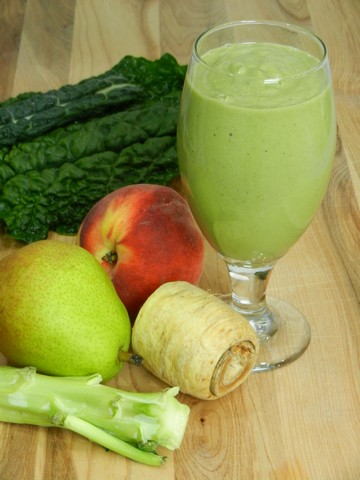
Early this past summer my husband surprised me with a Blendtec blender. My first thought was “do we really need such a fancy blender”, but then he showed me what it could do. He had seen demonstrations at Costco, and after doing some research, he felt he had found the right one for our family. He demonstrated it for me here at home, and I was totally sold! I never knew just how easy it is to use a surprisingly large variety of produce to make juices full of nutrition and fiber. And you don’t have to have a fancy, powerful blender to do it, but it sure helps. Our cheap OLD one could never have handled all that this new one can do. Here’s a link to the Blendtec at Amazon that is the closest to the model we own, also the best price out there that I can find. There are lots of reviews as well, on different models. Vitamix blenders are very good as well, so here’s another link, to Vitamix on Amazon, for comparison. I’m sure there are many other brands out there that will also do a great job. The point is, this is easy to learn and will benefit your health greatly. You don’t have to follow a recipe, just get an idea of what to do, then get started with whatever you have on hand.
Some related posts I recently wrote, with links to the best prices of various machines used for juicing and smoothies:
* In my post “Juicing: Comparing Blenders to Extractors,” I explain why we chose a blender over an extractor juicer.
* In “Which is better, Blendtec or Vitamix? Why We Chose Blendtec,” two popular and powerful blenders are compared.
* I also wrote a post in which I compare the juicers Breville and Hamilton Beach, “Juicers: Comparing Breville to Hamilton Beach.”
Smoothies and whole juices
We mostly use our blender to make smoothies, or whole juice as it’s also called. This juice contains all of the pulp, which makes it thick in consistency, though you can thin it as much as you want by using water, milk, juice, or other liquids. Since the pulp is included, you get the benefits of a high fiber drink with very little waste, since more parts of the produce can be used than when you simply eat it whole. Sure, you can eat strawberry greens and water melon rinds along with what is typically served, but who does??? In a blender, you can add these edible parts without even noticing. Some produce parts are not edible, however, so check first. Toward the end of this post is a short list of edible and non-edible parts, and a link to longer, more comprehensive lists.
Most of us are convinced we ought to eat more fruits and vegetables, and maybe a better variety of them. But it can be hard to do. Doesn’t it sound great to be able to quickly and easily add a ton more in your diet, and enjoying it at the same time? For me, adding more produce has often been a chore up until now. I like to get done with a meal and move on, but raw fruits and veggies take a while to eat. Making whole juices, however, is about as pain free as it gets. It’s like a dream, adding all this goodness and not feeling like it’s a drag. Just blend it up and drink it, enjoy it, and know that you’ve done yourself a tremendous favor!
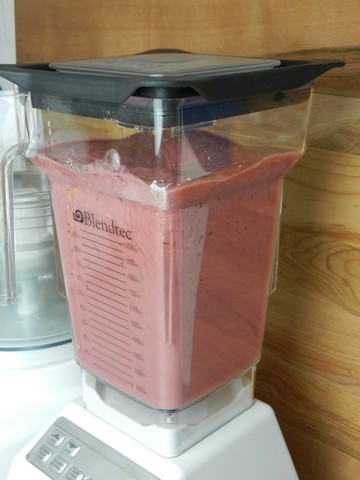
How does juice with vegetables taste?
It very much depends on what you add. If you focus solely on fruits and berries, you can end up with a very fruity, sweet dessert drink. If you add vegetables, it all depends. Some are stronger tasting than others. I have found that spinach is easy to add, and though it sometimes changes the color to green, it doesn’t change the flavor. If using a lot of vegetables the flavor won’t be as sweet, and maybe not as tasty as a fruit smoothie, but not bad at all. Adding celery or peppers can give it more of a pungent flavor, but when using milder tasting veggies it usually taste pretty good. Like a meal, not a dessert, though usually somewhat sweet. I’m not going to tell you that these juices taste heavenly or amazing; they are not necessarily delicious in the way you might crave another helping, but it tastes OK, good, sometimes great. It very rarely tastes bad, though celery is one I’d rather do without. I don’t care for celery, and the flavor comes through for sure.
Using a blender to make whole juice: What’s the big deal, anyway?
I have found whole juice to be a convenient way for me to be able to easily and quickly eat a large volume of produce. Not only that, but a variety that I ordinarily would never manage if I had to bite into and chew it all. I usually make a meal of these juices, so then I don’t need to worry about making something else in addition. After making whole juices and smoothies all summer, I am therefore very excited to write about and share with others, this discovery of easily added nutrition to everyday life. I feel like I’ve discovered gold! Another great thing is that you really don’t need a recipe. You can add a little bit of this and that, and experiment to see what the result is. I never measure anything, just use what I’ve got on hand. The result is somewhat different every time.
Depending on what you’re making, there are several programs on the Blendtec machine, but mostly I use the “Whole Juice” program. “Soups” actually heats liquids up, using friction.
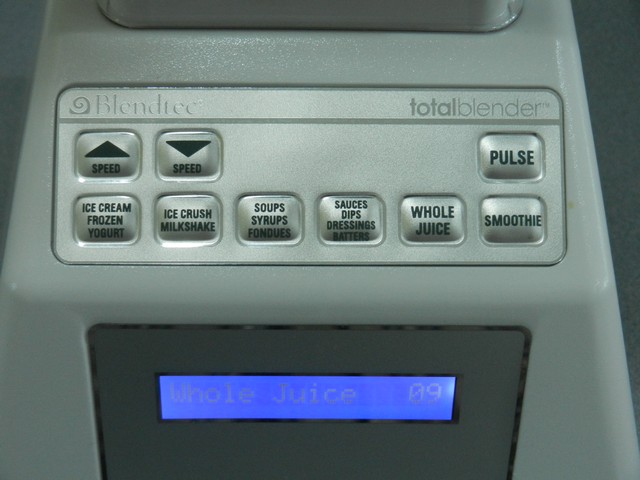
Is a smoothie powder needed, and what about sugar?
Well, I never do. I really don’t see the need for it. In all honesty, I don’t really know what those powders at the store do, anyway, but I’m guessing the ingredients are likely to be mostly chemicals and junk, so why use it when it’s not needed.
As far as addinb sugar, it would depend on whether you’re looking for dessert or a healthy meal or snack. Personally I rarely add sugar. I use my blender to whip up healthy, nutritious, drinkable meals, so if they aren’t as sweet as milkshakes, I’m OK with that. Adding a half (or a whole) ripe banana will add a lot of sweetness, so that’s a very good option if you want it sweeter than it is without. Truly, even if I want a dessert smoothie, I’ll blend up berries along with some yogurt and juice or milk, add some banana to it, and it’s sweet and super yummy. Honey is another option that I definitely consider to be more healthy than sugar. Then you have stevia, a powder or liquid derived from plant leaves, that in small amounts adds sweetness and is considered a very healthy choice. (Check out this link: Benefits to using stevia)
Some smoothie / whole juice ideas to get you started
In the picture at the top of this post, you can see which ingredients were used to create this beautiful, green smoothie. Kale, peach, pear, a piece of parsnip, half a stem of broccoli, plus some liquid. Green, leafy vegetables such as kale and spinach are very deeply colored and will affect the color of your juice. Since the other ingredients in this juice are more neutral in color once they are blended, the kale’s green color will shine through and dominate. Other types of produce that will dominate the color are berries, which often produce pink or purple colors. Raspberries = pink, blueberries or black berries = purple. Then you have beets, which won’t affect the flavor much, but will take over everything color wise, and create a beautiful red’ish / pink drink. Thus, if you end up with a blah-looking smoothie and your kids (or yourself!) won’t drink it because it looks yucky, just cut off a piece of raw beet to add, and it will look wonderful! Otherwise, add some berries to reach the same result.
Just look at this smoothie that I made for lunch today, how the color changed as it blended, and changed again after a piece of beet was added. (Ingredients: orange, grapes, piece of mango, a carrot, some kale, and a little water.)
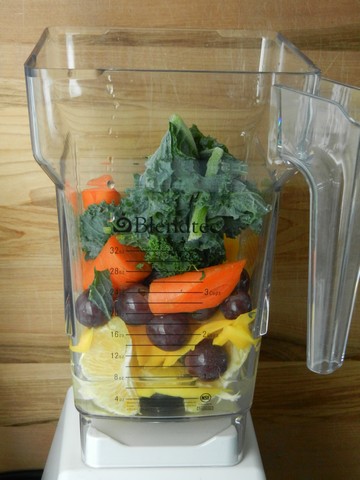
Looks promising, color wise…
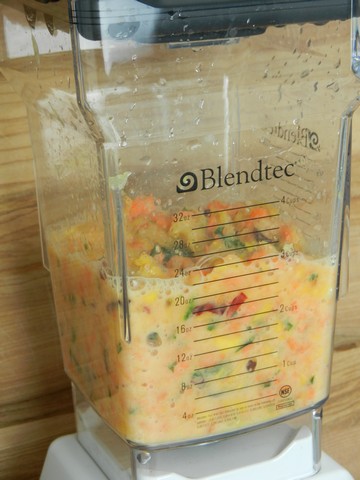
…until the kale starts to blend with the rest.
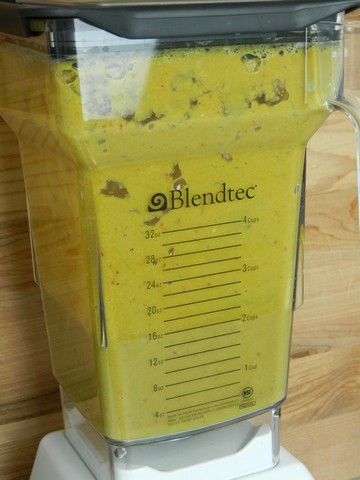
Not a very pretty color, but watch what happens when I add a piece of fresh beet (beware though, the stuff stains everything from fingers to cutting boards and counters!!)
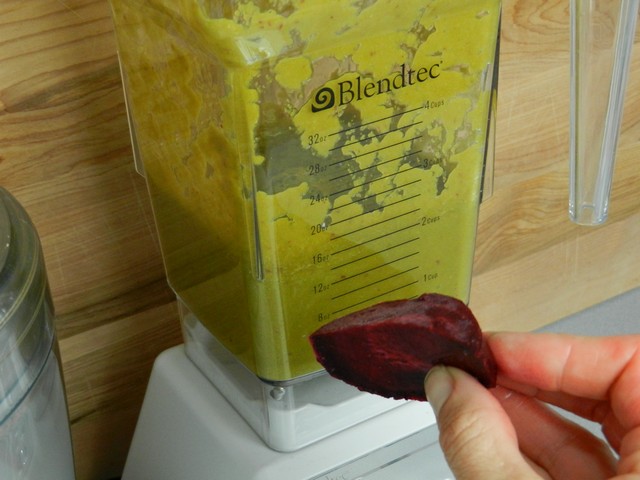
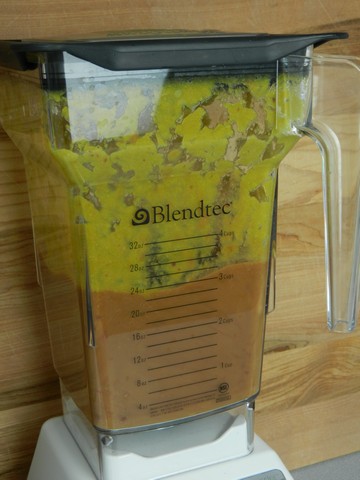
And there you are; pink /red’ish juice instead of a funky green.
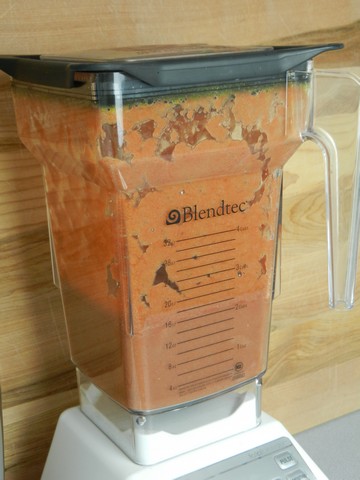
So here we go, ready to make a smoothie full of all kinds of goodness. I just take a bit of this and that, whatever I find in my refrigerator or in the garden. I tend to overdo it and end up making a much larger smoothie than planned for, and often times some of the stuff I plan to add doesn’t even fit in the jar. That did happen with the next juice I’ll show you. I’m just having too much fun, and want to add more and more ingredients because it’s all so good for you! This time I ended up putting away the frozen pieces of watermelon that are in the bowl together with frozen berries. There simply wasn’t room for it.
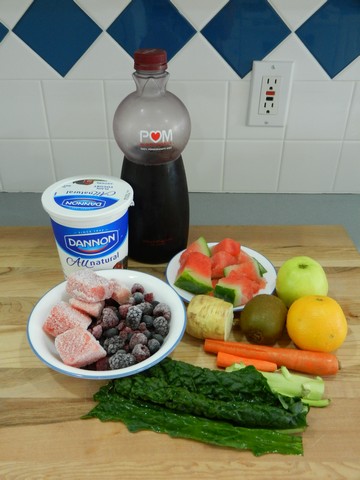
The ingredients used this time were:
Plain Greek yogurt, an orange, pomegranate juice…
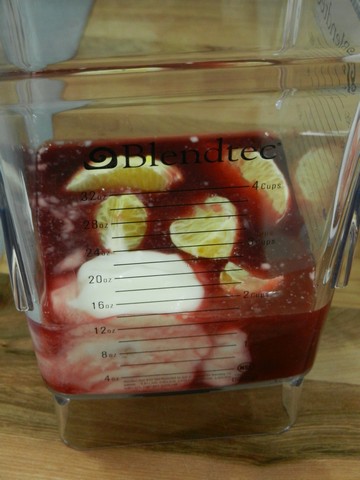
…adding kale, a kiwi, an apple, a carrot, a piece of parsnip (a good size chunk), half a broccoli stem. I cut them into chunks that can rotate as the blender spins; a carrot, let’s say, I cut into three pieces or so. And the recommendation is to always put the softer ingredients in first, ending with the harder ones. Sometimes I get a little mixed up though.
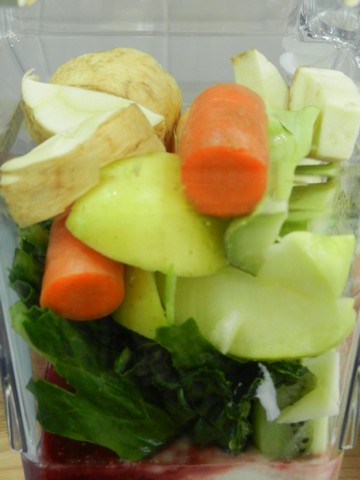
Then I topped with some watermelon (with the rind) and frozen berries. At the end, I poured in some cold water. I don’t measure the liquids, just pour in a bit. I think it usually comes up to the two cup mark once the produce is in there. Liquid is necessary so the foods will mix up and not get stuck half way up the jar.
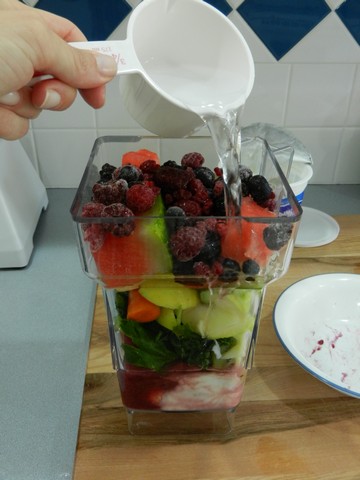
If there is room, I sometimes add ice as well. This time there was no room for ice. In fact, there really wasn’t room for the lid either. But I put it right on top and held on to it. I wouldn’t necessarily recommend this to others, but it is what sometimes happens in my household when I get too excited.
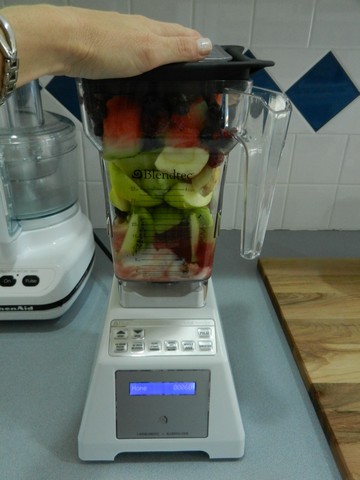
I push the “Whole Juice” button and let it do its thing while holding onto the lid. Usually I would let go of it, but not this time. At least not yet. This part is always so exciting, watching and seeing it all turn into liquid, changing color along the way.
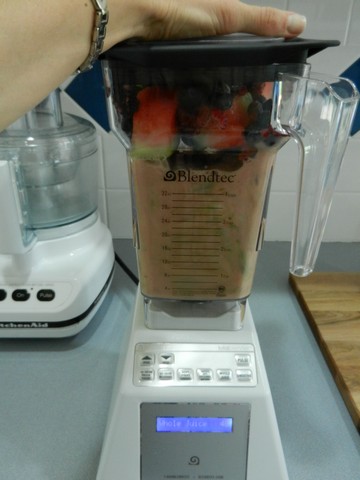
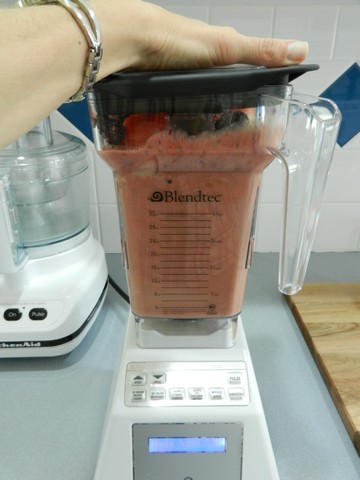
There! It’s done. The container is full to the brim! Now I have to find enough family members to help drink it. Or I can freeze it in portions for later. One thing is for sure: I could never drink this much all by myself! One glass, or a little bit more, is plenty for me. It really fills me up. It doesn’t necessarily last me for too many hours though, which is why I usually will add a protein and some fats or oil, which gives you a full feeling for a much longer period of time. I usually add protein and fats in the form of Greek yogurt, low sugar whey protein powder, avocado, or flax seeds.
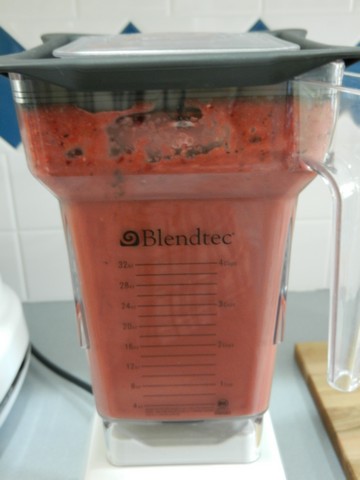
As you can see, no sugar was added. Not even banana. It was still good, and sweet enough for my taste. And no artificial colors or flavorings.
There is enough for a third glass this time, each of which measures 12 ounces (1 1/2 c).
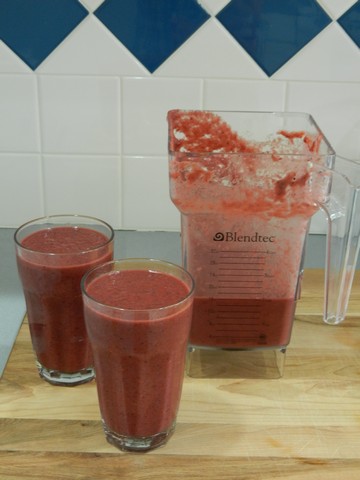
A tip I’d like to add, before I go on to the next juice:
Sometimes I’ll freeze items I never thought of freezing before. For example, after my son accidentally threw a bag of cut up watermelon in the freezer instead of the fridge, I found that they make excellent ice cube replacements! So if I have more than we can eat, I’ll just freeze a portion. I also have found that I am unable to use up a whole “head” of kale before it spoils, so instead of throwing it out after a while, I simply wash and freeze it. This leafy vegetable is easy to break apart or crush when frozen, and works great in the blender.
My next batch uses fruits and berries only, no vegetables. Still no sugar added, other than what’s found in the protein powder I’m about to use.
The ingredients added this time are:
Garden strawberries with stems, a chunk of mango, plumb, peach, pear, orange, and frozen berry mix (blueberries, raspberries, blackberries)…
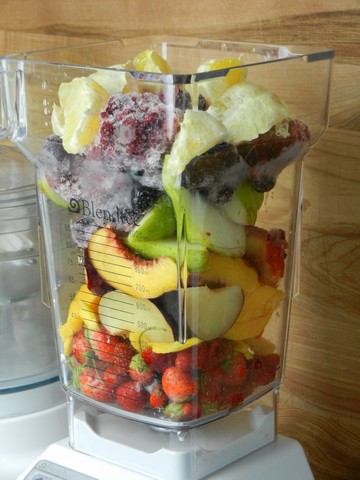
…and whey protein powder (I like Jillian’s, because it seems pretty clean with low sugar / additives), whole flax seeds (will grind up in the blender to release nutrients and oils), and adding some pomegranate juice. Water, milk, or other juices are just fine to use as well. Just whatever you have on hand.
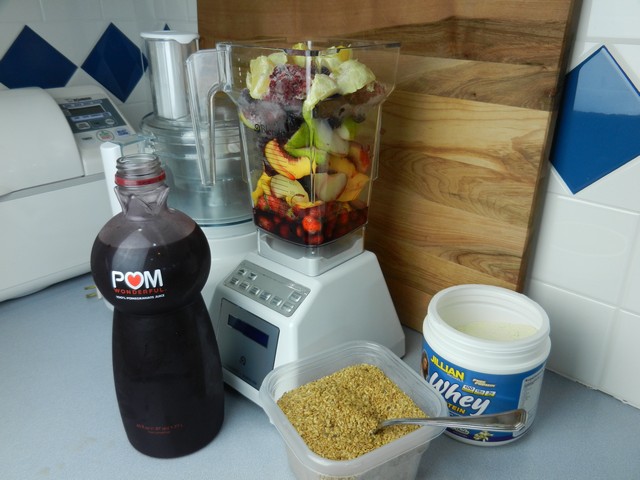
Here go flax seeds…
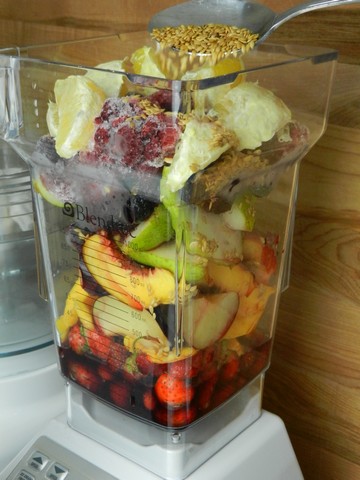
…and protein powder.
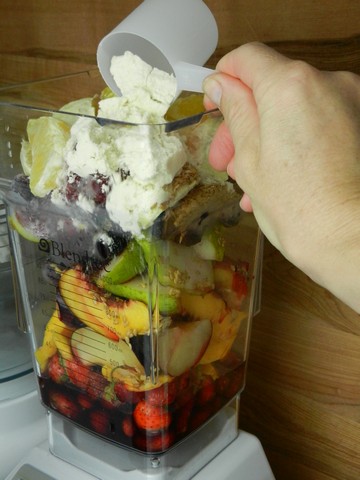
Whizzing away…
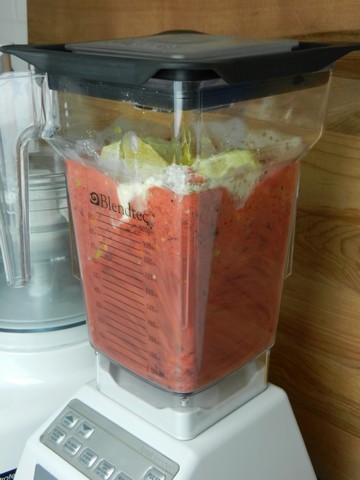
There we go. Thick and smooth. If it’s too thick for your taste, just add some water.
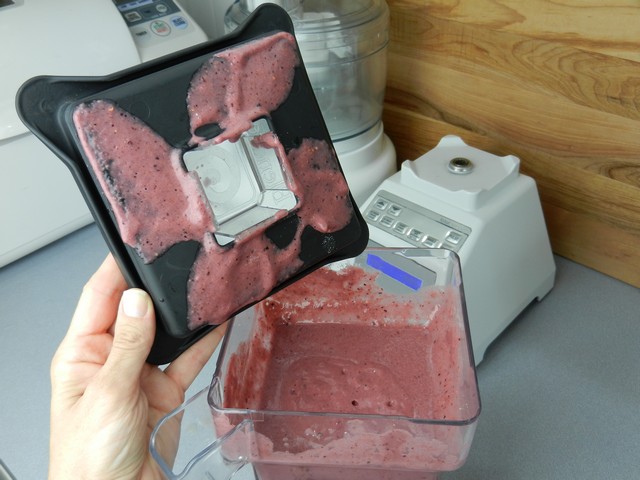
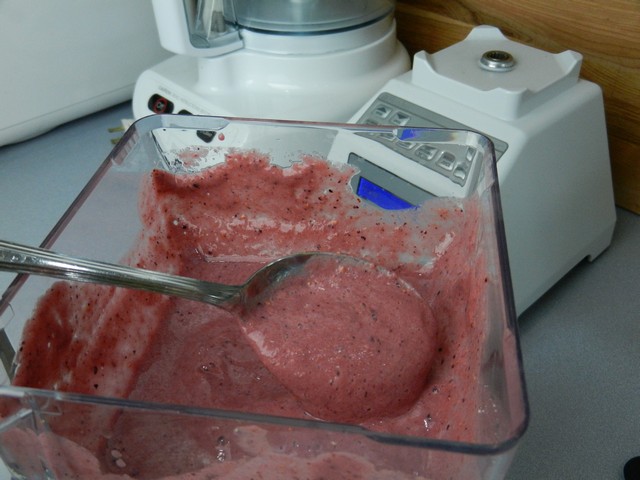
Preparing produce
I wash almost everything, and use peel as much as possible. All pits and seeds should be removed, unless you know for a fact that they are safe to eat. A lot of them are not edible and can be poisonous, especially if chewed or ground up (as in a blender) and eaten in large quantities. Here’s a link to a very good list to edible parts, with an interesting article. And here’s another link to another list of mostly veggies.
These are some of the fruits and veggies I’ve used so far, and how I prepare them:
Apple / pear: Keep the peel, but cut away the core and seeds
Orange: Peel, remove the largest parts of the white (can be bitter)
Kiwi: I peel, but it isn’t necessary. The peel can be a bit bitter and can be high in pesticides.
Carrots, parsnips, beets: Cut away the top, but leave the peel on. Actually, beet greens are edible. For skins, often times there is a lot of nutrition in, and immediately under the skin, so peeling removes nutrition. Select smaller, skinnier parsnips.
Turnips: If tiny, peel can be used. If larger than golf balls, peel. Smaller is better when used raw.
Broccoli: I usually use the thick stems in juices, and save the florets for dinner. The stems are nutritious.
Watermelon: Keep the whole rind on, or at least the thick, white part. Just cut into chunks that are small enough not to get stuck in the container. The rind is very good for you, so why waste it.
Avocado: I peel these, and throw out the seed; the seed is edible though, and nutritious, but quite bitter.
Mango: Same as for avocado, though I don’t think the pit is edible.
Strawberries: Up for discussion; for now, I’ll just keep the stems / greens on.
Other plants I use in whole juice:
Bell peppers, tomatoes, banana, pineapple, kale, spinach, green beans, peach, berries. There are lots more available on the marked that can be used for juicing, just use your imagination, give it a try, and have fun in the process!
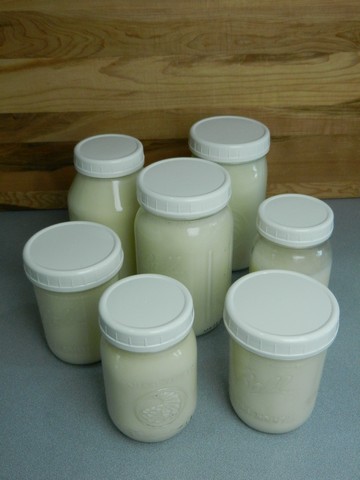
We love our Blendtec! We got ours from Costco too. Thanks for all the great recipes!
You’re very welcome! It’s a wonderful machine! Have you tried the spinach ice cream? Ours turned out more like a thin milkshake, but it was very good!
I have been researching the advantages of the Blendtec or the VitaMix, as opposed to the juices I now use, in terms primarily of nutrition, but tasty enough to be enjoyed. First of all your website is outstanding. My idea is to put together a program with Blendtec, to design and deliver to offices that would provide at lunchtime a smoothie, with nutritional make-up designed by a qualified organization. This will be provided at no financial cost to the employee, but would serve the interests, of both the employee and employer, since good health is a win-win reality. It would also being a savings of cost and time. As an alternative they could arrange to provide coupons redeemable at a local smoothie operator. Step one, would be to design the ingredients and the process rules of what products, seeds and skins to be included. For the past three years, I have adopted a diet that eliminated all dairy and meat products, and changed my health dramatically. And I am interested in sharing this change with others. I started on this program by reading The China Study,and recently read Forks over Knives, which suggests that eating red meat is almost an act of treason against humanity. I have not thought through the logistics of selecting,gathering, cleaning the ingredients, and whether the equipment could be on a food truck or located on premises. Appreciate your thoughts
Sounds like an interesting idea. I don’t know much about running a business, and whether your ideas are feasible, but I suppose one of the challenges would be to find offices who are willing to invest in your business, who will come to believe in it, since it would be an extra cost up front to them even if they save money in the long run. For the employee, were you thinking that it would be time saving in that they would take a shorter lunch break? If so, I don’t know if people are willing to sacrifice this much-loved time of day, but who knows. Maybe if they found saving money and eating healthier valuable enough to work through this hour. Personally I do believe in meat, even red meat, so we differ on that one. Sorry…
I loved this post! I have a Vitamix and use it every single day to make a HUGE green smoothie for breakfast! I have a juicer as well but use it less often since it strips away all the fiber. My typical morning smoothie includes: 1 tbsp flax seeds, 1 tbsp chia seeds, 1 tsp chlorella powder, 2 tbsp hemp protein powder, 1 packet stevia, 3 handfuls of baby spinach or kale, 1-2 whole carrots, 1 banana, 1-2 cups frozen fruit, 1.5 cups water or almond milk. Sometimes I’ll add cocoa powder or peanut butter to change up the flavor a bit. I can usually only drink about 2/3 of this for breakfast and save the rest for a snack later in the day. I really want to get in the habit of adding more of a variety of vegetables to my smoothie, not just leafy greens and carrots.
Sounds like an awesome breakfast! I do love how you can make so many changes and get great nutrients in without much hassle. There’s no way I would eat all that straight, but ground up and inside a drink, it goes down easily.
So I have a blendtec, and I’ve been doing green smoothies mostly frozen fruit (sometimes I add fresh banana or half an orange), almond milk, and green, with flax seed. I use the smoothie button. Is the whole juice button for water and water based fresh fruit (thinner drinks)? And the smoothies for thicker drinks? I want to whole juice and everyone just keeps telling me to add water to my smoothies but my smoothies have milk to make them creamy so I wouldn’t want to add water. Any help?
I use the whole juice button anytime I add anything firm that takes a while to chop up. My whole juices are always very thick, but thin would be fine as well. I almost always choose this setting, mostly out of habit. I think it does a great job at blending everything, no matter how hard it might be. It does ice too. I do add water or juice, since the mass usually otherwise will be too thick and simply won’t swirl around like it should while the blades are working. If I wanted to make a real smoothie, which to me is a blend of only berries or with some fruits as well, I will choose the smoothie button. I have to take the time to read the manual again to see what it says to use these buttons for, but it doesn’t seem to be a big deal to me; if there are still lumps left, I’ll just blend it up again. Personally I would still call it a smoothie even if it has no milk in it, but that might not technically be a true smoothie then… ??? I think it’s up to you what you want to use, but the liquid doesn’t have to be water if you prefer to use only milk. Whatever you want. 🙂 No biggie.
I was reading the recipes on the blendtec website. The only difference between the smoothie button and the whole juice button is that the whole juice runs a bit longer, I think 10 seconds?? I use that one too when making a green smoothie, just to make sure all the raw veggies are blended up good.